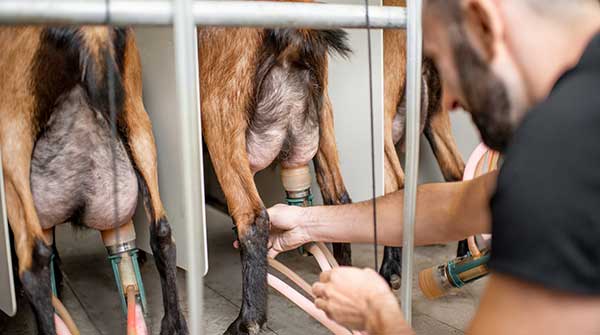In a break from the past, CDC recommends a modest 1.77 increase in farm milk price
 The recent decision by the Canadian Dairy Commission (CDC) to recommend a modest 1.77 percent increase in farm milk prices is a commendable move that should be celebrated by consumers. Every year, the CDC announces the compensation for dairy farmers operating under our supply management regime, and this year’s adjustment is a modest yet meaningful one.
The recent decision by the Canadian Dairy Commission (CDC) to recommend a modest 1.77 percent increase in farm milk prices is a commendable move that should be celebrated by consumers. Every year, the CDC announces the compensation for dairy farmers operating under our supply management regime, and this year’s adjustment is a modest yet meaningful one.
The genesis of this increase can be attributed to the CDC, which advocated for this raise in farm milk prices for 2024. Evidently, both farmers and the Commission astutely gauged the prevailing circumstances.
One interesting aspect of this development is the three-month delay in implementing the price increase, now scheduled for May 1, 2024. The CDC’s decision to postpone the scheduled milk farmgate price increase was influenced by the ongoing challenges faced by the food industry in maintaining stable food prices.
| Related Stories |
| Canada’s marketing boards a barrier to affordable food
|
| What’s really behind higher milk prices
|
| It’s time for Canada’s protectionist barriers to fall
|
This modest increase represents a significant departure from the substantial raises of previous years. In February 2022, a record-breaking 8.4 percent increase was imposed on consumers, followed by a 2.5 percent increase in September 2022. In February of this year, dairy farmers received another 2.2 percent increase. Consequently, this recent announcement stands as the lowest increase we have witnessed in recent years.
Inflation has taken its toll on consumers at the grocery store, with double-digit food inflation rates. Dairy manufacturers have been grappling with unprecedentedly heightened input costs stemming from the CDC’s previous decisions. However, the projected dairy inflation crisis has not materialized to the same extent at the grocery store, with most dairy product prices closely following the general food inflation rate.
According to Statistics Canada, retail prices for fluid milk have surged by an average of eight percent since February 2022, following the infamous 8.4 percent increase. Cream prices have risen by three percent, while butter prices increased by seven percent during the same period. The price increases for cheese and yogurt did not exceed 10 percent since February. Ironically, during that same period, non-dairy alternatives like soy milk increased by 11 percent and margarine by a staggering 43 percent. Nonetheless, questions about the credibility of this data from Statistics Canada linger.
The debate around supply management and dairy farming in Canada has generated strong opinions, some of which are certainly valid. Canadian farm milk ranks among the most expensive in the Western world. Dairy farmers received quotas for free many years ago, estimated to be worth well over $25 billion. Shielded by high trade barriers and the ability to discard excess milk without full public disclosure, the industry remains conspicuously opaque from a social responsibility perspective, with added compensation from Ottawa.
Each farm receives hundreds of thousands of dollars, all under the pretense that Ottawa believed dairy farmers would suffer financial losses due to ratified trade deals. However, dairy farmers have not incurred any financial losses; the system’s complexity even baffles politicians, influenced by the Dairy Farmers of Canada, who readily support the farming group’s arguments. Ultimately, it is the consumers who bear the cost.
Nonetheless, we must emphasize the resilience of the supply management system. Canadians have access to a consistent supply of high-quality dairy products, and that’s the truth. As observed in recent months, prices have largely tracked inflation. In the United States, where a federal supply management scheme is absent, the dairy section has experienced volatile price fluctuations, at times exceeding 100 percent. The enduring legacy of supply management is the stability it affords.
The challenge, however, lies in the fact that our dairy sector is not particularly competitive, primarily due to the absence of a competitive imperative for dairy farmers. They appear to pay limited attention to consumer trends, at least not to the extent required. The onus of innovation falls on dairy manufacturers, who must navigate the terrain of rising input costs, a challenging task when consumers are becoming increasingly price-conscious.
Many may harbour hopes of a new system, but given the fiscal and political complexities entwined with the existing regime, Canadians will likely be tethered to it for the foreseeable future.
Despite supply management, Canada may face losing half of its dairy farms by 2030. This may prompt policymakers to prioritize competitiveness, potentially involving the development of export quotas while supporting the younger generation of dairy farmers who possess a better understanding of the evolving global landscape. Their market may extend beyond Canada’s borders.
Dr. Sylvain Charlebois is senior director of the agri-food analytics lab and a professor in food distribution and policy at Dalhousie University.
For interview requests, click here.
The opinions expressed by our columnists and contributors are theirs alone and do not inherently or expressly reflect the views of our publication.
© Troy Media
Troy Media is an editorial content provider to media outlets and its own hosted community news outlets across Canada.


